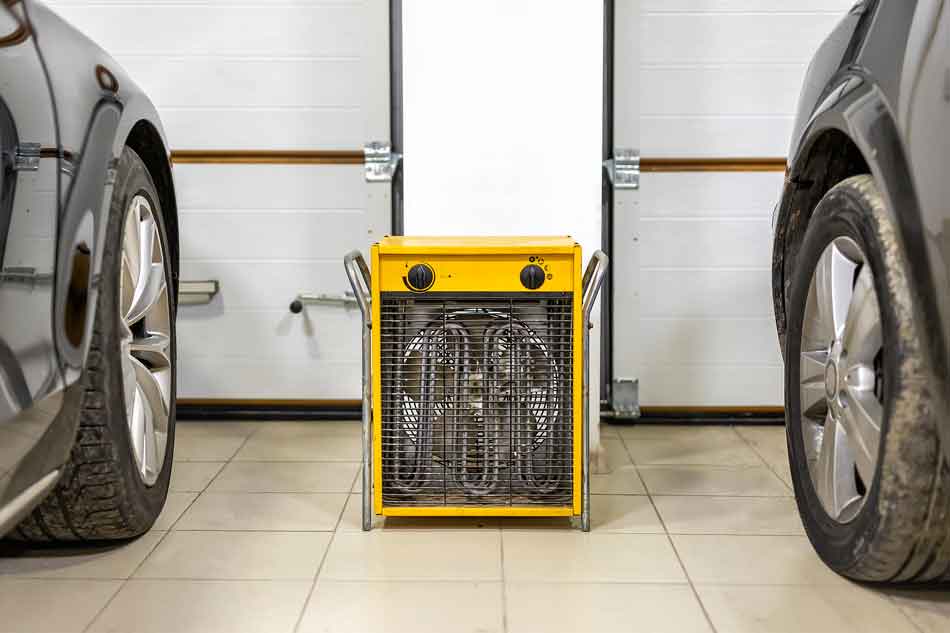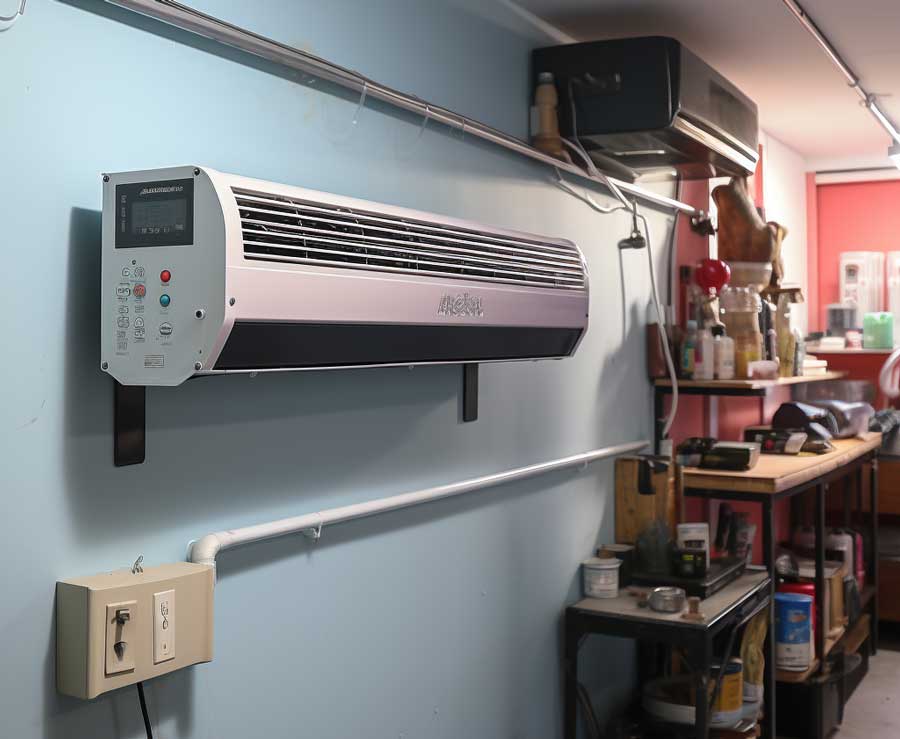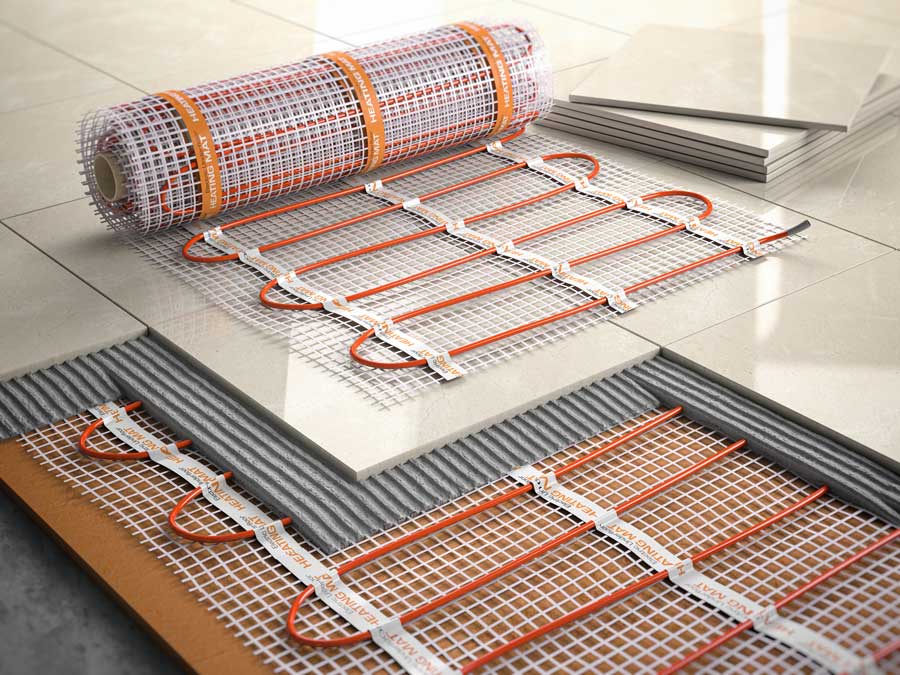Ever stepped into a chilly garage and thought, “There must be a better way!”? You’re in the right place!
In this article, we’ll cover the 7 cheapest ways to heat a garage. We’ll explain how each method works, weigh their pros and cons, and potential costs.
Let’s get started!
Cheapest Ways to Heat a Garage
Next, we’ll explore five popular garage heating solutions, weighing their pros and cons. Plus, we’ll see which ones you can easily set up yourself. This will help you choose the most suitable heating method for your garage.
Infrared Heaters
Infrared heaters use infrared radiation, a type of invisible light, to produce warmth. Unlike traditional heaters that warm the air, infrared heaters directly heat objects or people in their line of sight. Infrared heaters are one of the cheapest ways to heat a garage, offering some unique advantages and challenges.
Pros:
- Efficiency: Almost all the electricity they use is turned into heat. This efficiency can result in cost savings over time.
- Quiet Operation: Without fans or moving parts, these heaters operate silently and emit a gentle glow.
- Safety: Their surfaces remain cool to the touch, reducing burn risks. They also don’t consume oxygen or emit carbon monoxide, promoting a healthier environment.
Cons:
- Coverage: They only heat what’s directly in their path, so improper positioning can lead to cold spots.
- Aesthetics: Some models may appear too bulky or basic, possibly conflicting with room decor.

Choosing the Right Infrared Heater:
- Size & Power: Match the heater’s size and wattage to your room’s dimensions. For instance, a 200 sq. ft. room typically needs a 2000-watt heater. Remember, more wattage means more heat but also more power consumption.
- Features: Modern heaters include remote controls, digital displays, and safety features. Opt for those that meet your needs and safety standards.
- Design: These heaters vary from portable to wall-mounted designs. Pick one that complements your room’s aesthetics, fits the space, and suits your budget.
Understanding Costs: Knowing the operational costs associated with infrared heaters is vital. Costs depend on local electricity rates, heater wattage, usage duration, and room insulation. For instance, a 1500-watt heater running 6 hours every day might cost around $36 a month for a 200 sq. ft. space. For larger spaces, like a 330 sq. ft. living room, expect expenses around $55 monthly. On the energy front, a 1500-watt heater consumes about 1.5 kW per hour, totaling around 270 kWh monthly if used 6 hours daily.
Method 2: Electric Space Heater
Electric space heaters are an excellent solution for warming small areas. They use a heating element—like a coil, wire, or ceramic plate—that heats up when powered. The heat is then spread to nearby air, either naturally or with a fan’s help. However, these heaters are better for localized heating rather than even room warmth.
Pros:
- Affordability & Simplicity: Just plug them into a standard outlet. No installation or regular upkeep is needed.
- Adjustability: Features like thermostats, timers, oscillation, and remote controls let you customize your heating.
- Portability & Variety: Easily move them between rooms and choose from styles like tower, pedestal, and wall-mounted, making them ideal for places like garages and basements.
Cons:
- Noise: Some models can be loud because of fans or moving parts.
- Safety Concerns: If misused, there’s a risk of fire or electric shock. Avoid placing near flammable items or using space heaters with extension cords.
- Energy Consumption: They can increase your electricity bill, especially in larger or poorly insulated areas, due to their inefficiency.

Choosing the Right Electric Heater:
- Type: Radiant heaters provide direct warmth using infrared rays—great for spot heating. Convection heaters warm the surrounding air, suitable for whole rooms.
- Size & Power: As a rule of thumb, 10 watts per square foot is needed. So, a 2000-watt heater is apt for a 200 sq. ft. room.
- Safety First: Look for features like tip-over and overheat protection, cool-touch exteriors, and auto shut-off.
- Efficiency: Opt for energy-efficient models or those with an Energy Star rating to save costs in the long run.
Understanding Costs: A 1500-watt electric space heater running 6 hours daily might cost around $36 monthly. For a 330 sq. ft. living room with a 2300-watt heater, the expense could be about $55 monthly. A 1500-watt heater uses 1.5 kW per hour, leading to around 270 kWh monthly if used for 6 hours daily.
You can check out this comprehensive resource for an in-depth guide on using electric space heaters in garages.
Method 3: Kerosene or Propane Space Heater
Kerosene and propane space heaters are top contenders when heating large spaces like garages, basements, or workshops. They work by burning their respective fuels, and their design typically includes a burner, fuel tank, and either a fan or reflector for heat distribution. These heaters stand out due to their high BTU (British Thermal Unit) ratings, showcasing their impressive heat output. For perspective, a 75,000 BTU kerosene heater can warm up to 1,875 square feet.
Pros:
- Portability: Easily move them from place to place.
- Versatility: Multiple types are available, including forced air, radiant, convection, and cabinet.
- Emergency Preparedness: They’re perfect during power outages or extreme cold.
- Cost-Efficiency: They often cost less to operate than electric heaters and heat larger areas faster.
Cons:
- Maintenance: Regular upkeep is essential. This includes cleaning burners and tanks.
- Emissions: These heaters can emit harmful gases, leading to health issues with prolonged exposure.
- Safety: They require careful handling, especially regarding fuel storage and safety from potential fire hazards.
Safety Tips:
- Store fuel in sealed containers away from ignition sources.
- Position heaters on stable, non-combustible surfaces and keep them at least 3 feet away from flammable items.
- Always turn off heaters when not in use, keep smoke and CO detectors active, and have a fire extinguisher nearby.
- Check local regulations; permits might be needed for heater use.
Understanding Costs: Costs depend on local fuel prices and insulation quality. Certain estimates suggest a 75,000 BTU kerosene heater used 6 hours daily might cost about $18 monthly, while a 40,000 BTU propane heater would be around $22. In terms of fuel, the kerosene heater would use roughly 0.56 gallons per hour or about 101 gallons a month.
Check out our detailed guide for a deeper dive comparing kerosene, propane, and electric heaters.
Method 4: Mini-Split Heater
When warming your garage, the mini-split heater emerges as a modern and efficient choice. A mini-split heater is a heat pump designed for heat and cool spaces without extensive ductwork. It has an outdoor unit with a compressor and condenser and an indoor units with an evaporator and fan. These are connected by refrigerant lines through a small wall opening. In cold months, it captures exterior heat and releases it inside, and in summer, it pulls indoor heat out.
Pros:
- Efficiency: Unlike traditional heaters that generate heat, mini-splits move it. This minimizes energy loss common in ducted systems. In fact, ENERGY STAR suggests you might save up to 30% on heating and cooling costs compared to standard systems.
- Quiet Operation: With noisy parts located outside and silent indoor units, you can enjoy a peaceful indoor atmosphere.
- Zoning: The ability to set different temperatures for various indoor units caters to personal preferences and can further enhance efficiency.
Cons:
- Cost: Mini-splits have higher installation costs, ranging from $2,000 to $14,500. Their specialized nature means you’ll need a professional setup.
- Aesthetics: Indoor units are visible, which might not suit everyone’s decor taste.
- Outdoor Noise: While the inside is quiet, the outside unit can sometimes be noisy, which could bother neighbors.

Choosing the Right Mini-Split System:
- Size Matters: You need roughly 10 BTUs for every square foot. A 400-square-foot garage, for instance, would need around 4,000 BTUs.
- Power and Efficiency: SEER (Seasonal Energy Efficiency Ratio) gauges efficiency. A higher SEER indicates better performance. While 13 is the base SEER for mini-splits, premium models can reach over 30.
- Placement: The outdoor unit should be shaded and well-ventilated. In contrast, the indoor unit should ideally be central for even air distribution.
Understanding Costs: ENERGY STAR estimates the average annual cost to run a mini-split in a 600-square-foot space at $378, compared to $1,064 and $657 for traditional electric and gas systems, respectively. Switching to a mini-split can lead to savings of 64% from electric and 42% from gas systems. So, while there’s an initial investment, the potential long-term savings and benefits can be substantial.
Method 5: Radiant Ceiling Panels
Radiant ceiling panels are similar to portable radiant heaters but cover your entire garage ceiling.
Operation is the same. Instead of warming the surrounding air like traditional heaters, these panels emit infrared radiation. This invisible light directly warms up objects and people below.
Pros:
- Longevity & Maintenance: These panels are a reliable choice with a lifespan of up to 20 years, especially when well-maintained. They’re hassle-free, without any noisy fans or moving parts to worry about.
- Air Quality & Comfort: Say goodbye to dusty heaters. Radiant ceiling panels won’t introduce allergens or pollutants into your space. Plus, they offer consistent temperature levels, keeping rooms uniformly warm from corner to corner.
Cons:
- Installation & Aesthetics: They might be pricier to install and may not always complement room aesthetics. Always ensure a professional electrician is handling the setup.
- Coverage: Their heat directly focuses below, so larger rooms or those with many obstructions may not warm up as evenly.
Choosing the Right Radiant Ceiling Panels:
- Size: One square foot of panel typically heats about 10 square feet of space. So, a 200-square-foot room would need roughly 20 square feet of panels.
- Power & Efficiency: Measured in watts, the panel’s power hints at its heating capability. But remember, more power can mean higher costs. Always opt for efficient models like those certified by ENERGY STAR.
- Design: From metal to ceramic or gypsum board, you have choices! Each has pros and cons, balancing heat output, appearance, and durability.
Understanding Costs:
Anticipate an average monthly cost of around $20 to heat a standard 150-square-foot bedroom. Energy-wise, a 250-watt panel running 6 hours daily for a month will consume about 45 kWh. Always consider your local electricity rates when budgeting.
Radiant ceiling panels can be a fantastic, efficient choice for many homeowners looking to add warmth from above.
Method 6: Radiant Heating Garage Floor
Radiant heating for garage floors, using electric wires or hot water pipes beneath the concrete, offers a modern approach to heating. When activated, the heat spreads upwards through the concrete, directly warming anything above. Unlike traditional heaters that heat the air, this system targets what it touches.
Pros:
- Comfort & Utility: It guarantees warm footing, reducing moisture and potential mold issues and making garages more inviting for various activities.
- Durability & Maintenance: With no exposed moving parts, it promises low maintenance and can last decades with proper care.
- Efficiency: By not relying on air, it saves energy. Combined with smart thermostats or timers, users might cut costs by up to 30% versus traditional heaters.
Cons:
- Installation Cost & Time: Professional setup, possible electrical adjustments, and potential floor replacement make it an investment in time and money.
- Performance: Some might find it slower than other systems. The heat can be uneven in larger or less insulated garages.

Understanding Costs: Costs depend on utility rates, system specs, usage, and garage insulation. For instance, running a 50-watt electric system for 6 hours every day might cost around $9/month, while a 100-watt hydronic system could be about $18/month. Potential savings depend on your existing setup and regional utility rates. Switching from an older electric to a modern radiant system could save homeowners up to 64% while transitioning from a gas system to a hydronic one might reduce costs by 42%.
Method 7: Insulation
Insulation is key to keeping your garage warm, especially in colder seasons. By acting as a barrier, insulation reduces heat loss from walls, roofs, doors, and windows, ensuring a warmer interior. More than just comfort, insulation can also save energy and reduce heating costs. In fact, insulating your garage can cut heating and cooling expenses by up to 30%.
Popular Insulation Options:
- Fiberglass Batts/Rolls: Common and budget-friendly, they fit between wall studs or ceiling joists. Be cautious during installation to avoid skin irritation or inhaling particles.
- Rigid Foam Boards: A pricier choice, but they excel in insulation performance and resist moisture.
- Spray Foam: Offers the highest insulation level, but it’s more expensive and needs professional installation.
Installation Tips:
- Clear the walls of any obstructions.
- Seal cracks to block cold air.
- Measure, cut, and fit insulation snugly without gaps.
- Apply a vapor barrier (like foil or paper backing) over the insulation to prevent moisture buildup.
- Consider drywall for a finished appearance.
- For doors, utilize insulation kits or consider an insulated garage door. For windows, insulation kits or caulking can help.

Additional Benefits:
- Acts as a sound barrier, reducing noise.
- Minimizes moisture issues, guarding against rust or mold.
- Deters pests, preventing hygiene and structural concerns.
Understanding Costs: The total cost and duration depend on garage size, insulation type, and labor charges. On average, insulating a 2-car garage might cost around $4,500 and take 2 to 3 days.
For a deeper dive into garage insulation, check out more additional tips and insights here.
How to Supplement Your Garage Heater
When it comes to keeping your garage warm, it’s not just about the primary heater.
Here are effective ways to augment your garage’s heating efficiency and comfort:
- Fans: Circulate warm air uniformly, eliminating cold spots. They also promote better air quality, which is essential for health and safety.
- Curtains: Curtains reduce cold drafts from doors and windows—the usual culprits for heat loss. They also add style and privacy to your space.
- Rugs or Heated Mats: Perfect for cold concrete floors, these provide warmth and cushioning, alleviating discomfort from long periods of standing or working.
- Ceiling Fan with Reverse Switch: Warm air rises, so use a ceiling fan to push this warmth back down where it’s needed.
- Plants: Elevate your garage’s atmosphere and improve air quality, neutralizing pollutants from sources like paint.
Why You Should Avoid Wood-Burning Stoves to Heat a Garage
Wood-burning stoves may offer a sense of nostalgia, but they’re not the best choice for garage heating.
Using a wood-burning stove raises safety concerns due to the risk of fires from sparks, flying embers, or if they’re too close to flammable materials.
Plus, having one of these stoves can increase your insurance premiums, sometimes between 0% and 5%. Insurance might even be voided in specific scenarios if the stove isn’t professionally installed.
Consider that wood-burning stoves are the second leading cause of home heating fires, contributing to a concerning 15% of all incidents.
So, while they have their charm, it’s clear that a garage might not be the best place for a wood-burning stove.
Wrapping It Up
We’ve discovered several methods how to heat a garage cheaply various methods, dissecting their advantages and potential challenges.
From DIY-friendly options to more advanced systems, there’s a fit for every garage and every homeowner. Remember, the right choice depends on your needs, budget, and comfort preferences.
Your cozy, well-heated garage awaits! Dive in and make it a reality.
